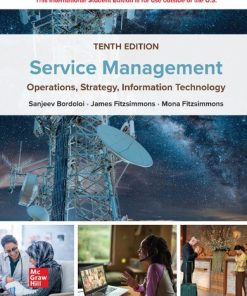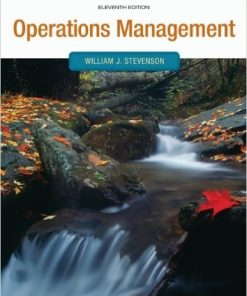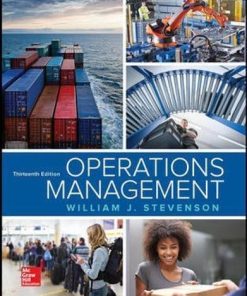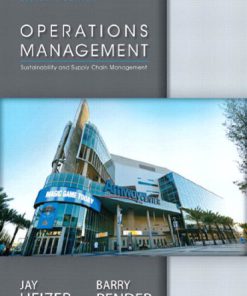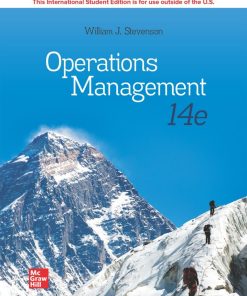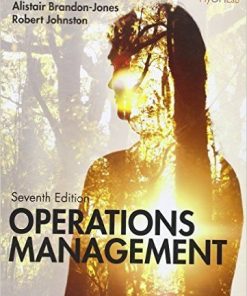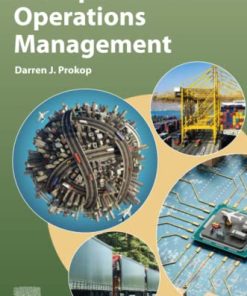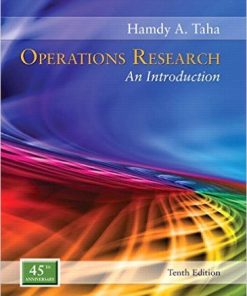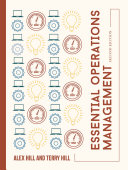(EBOOK PDF)Operations Management 10th Edition by Nigel Slack, Alistair Brandon Jones 9781292408217 1292408219 full chapters
$50.00 Original price was: $50.00.$25.00Current price is: $25.00.
Operations Management 10th Edition by Nigel Slack, Alistair Brandon Jones – Ebook PDF Instant Download/Delivery: 9781292408217, 1292408219
Full download Operations Management 10th Edition after payment
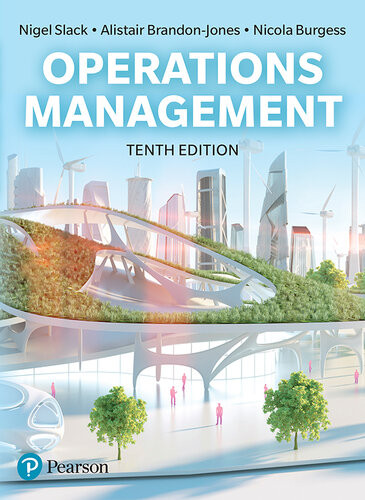
Product details:
• ISBN 10:1292408219
• ISBN 13:9781292408217
• Author:Nigel Slack, Alistair Brandon Jones
Operations Management
Operations may not run the world but make the world run! Learn how a business operates and improves its processes from some of the leading experts in the field. Operations Management, 10th edition is the ultimate guide on the subject, providing you with the best ways and strategies to learn, explore and make sense of how a business works, coming from world-leading experts Nigel Slack, Alistair Brandon-Jones, and Nicola Burgess. Strategic in its perspective and with a clear structure, the latest edition offers a comprehensive and practical way to study key concepts surrounding effective operation processes, from theory to practice. What makes Operations Management, 10th edition work so well? Clear structure, thanks to the “4 Ds” model of Operations Management. Real-life examples that are shown in the “Operations in Practice” boxes and case studies. Worked examples that blend qualitative and quantitative perspectives. Critical commentaries, posing alternative views where appropriate. Summary provided in practical bullet points, answering key questions. A new section in every chapter called “Responsible Operations”, that summarises how the topic touches upon social, ethical, and environmental issues. With plenty of new end-of-chapter case studies and a plethora of international examples, this textbook will challenge your critical thinking, both individually and as part of your group discussion in class. Along with the practice cases, summaries, and illustrations, this edition is the definitive guide for your studies in the field of Operations Management. Pearson, the world’s learning company.
Operations Management 10th Table of contents:
PART ONE DIRECTING THE OPERATION
1 Operations management
Introduction
1.1 What is operations management?
1.2 Why is operations management important in all types of organisations?
1.3 What is the input–transformation–output process?
1.4 What is the process hierarchy?
1.5 How do operations (and processes) differ?
1.6 What do operations managers do?
Summary answers to key questions
Case study: Kaston-Trenton Service (KTS)
Problems and applications
Selected further reading
Notes on chapter
2 Operations performance
Introduction
2.1 Why is operations performance vital in any organisation?
2.2 How is operations performance judged at a societal level?
2.3 How is operations performance judged at a strategic level?
2.4 How is operations performance judged at an operational level?
2.5 How can operations performance be measured?
2.6 How do operations performance objectives trade off against each other?
Summary answers to key questions
Case study: IKEA looks to the future
Problems and applications
Selected further reading
Notes on chapter
3 Operations strategy
Introduction
3.1 What is strategy and what is operations strategy?
3.2 How does operations strategy align with business strategy (top-down)?
3.3 How does operations strategy align with market requirements (outside-in)?
3.4 How does operations strategy align with operational experience (bottom-up)?
3.5 How does operations strategy align with operations resources (inside-out)?
3.6 How are the four perspectives of operations strategy reconciled?
3.7 How can the process of operations strategy be organised?
Summary answers to key questions
Case study: McDonald’s: half a century of growth
Problems and applications
Selected further reading
Notes on chapter
4 Managing product and service innovation
Introduction
4.1 What is product and service innovation?
4.2 What is the strategic role of product and service innovation?
4.3 What are the stages of product and service innovation?
4.4 How should product and service innovation be resourced?
Summary answers to key questions
Case study: Widescale studios and the Fierybryde development
Problems and applications
Selected further reading
Notes on chapter
5 The structure and scope of supply
Introduction
5.1 What is the structure and scope of supply?
5.2 How should the supply network be configured?
5.3 How much capacity should operations have?
5.4 Where should operations be located?
5.5 How vertically integrated should an operation’s supply network be?
5.6 What activities should be in-house and what should be outsourced?
Summary answers to key questions
Case study: Aarens Electronic
Problems and applications
Selected further reading
Notes on chapter
PART TWO DESIGNING THE OPERATION
6 Process design
Introduction
6.1 What is process design?
6.2 What should be the objectives of process design?
6.3 How do volume and variety affect process design?
6.4 How are processes designed in detail?
Summary answers to key questions
Case study: The Action Response Applications Processing Unit (ARAPU)
Problems and applications
Selected further reading
Notes on chapter
7 The layout and look of facilities
Introduction
7.1 How can the layout and look of facilities influence performance?
7.2 What are the basic layout types and how do they affect performance?
7.3 How does the appearance of an operation’s facilities affect its performance?
7.4 What information and analysis is needed to design the layout and look of facilities?
Summary answers to key questions
Case study: Misenwings SA
Problems and applications
Selected further reading
Notes on chapter
8 Process technology
Introduction
8.1 What is process technology and why is it getting more important?
8.2 How can one understand the potential of new process technology?
8.3 How can new process technologies be evaluated?
8.4 How are new process technologies developed and implemented?
Summary answers to key questions
Case study: Logaltel Logistics
Problems and applications
Selected further reading
Notes on chapter
9 People in operations
Introduction
9.1 Why are people so important in operations management?
9.2 How can the operations function be organised?
9.3 How do we go about designing jobs?
9.4 How are work times allocated?
Summary answers to key questions
Case study: Grace faces (three) problems
Problems and applications
Selected further reading
Notes on chapter
Supplement to Chapter 9: Work study
Introduction
Method study in job design
Work measurement in job design
PART THREE DELIVER
10 Planning and control
Introduction
10.1 What is planning and control?
10.2 How do supply and demand affect planning and control?
10.3 What is ‘loading’?
10.4 What is ‘sequencing’?
10.5 What is ‘scheduling’?
10.6 What is ‘monitoring and control’?
Summary answers to key questions
Case study: Audall Auto Servicing
Problems and applications
Selected further reading
Notes on chapter
11 Capacity management
Introduction
11.1 What is capacity management?
11.2 How is demand measured?
11.3 How is capacity measured?
11.4 How is the demand side managed?
11.5 How is the supply side managed?
11.6 How can operations understand the consequences of their capacity management decisions?
Summary answers to key questions
Case study: FreshLunch
Problems and applications
Selected further reading
Notes on chapter
Supplement to Chapter 11: Analytical queuing models
Introduction
Notation
Variability
Incorporating Little’s law
Types of queuing system
12 Supply chain management
Introduction
12.1 What is supply chain management?
12.2 How should supply chains compete?
12.3 How should relationships in supply chains be managed?
12.4 How is the supply side managed?
12.5 How is the demand side managed?
12.6 What are the dynamics of supply chains?
Summary answers to key questions
Case study: Big or small? EDF’s sourcing dilemma
Problems and applications
Selected further reading
Notes on chapter
13 Inventory management
Introduction
13.1 What is inventory?
13.2 Why should there be any inventory?
13.3 How much should be ordered? The volume decision
13.4 When should an order be placed? The timing decision
13.5 How can inventory be controlled?
Summary answers to key questions
Case study: Supplies4medics.com
Problems and applications
Selected further reading
Notes on chapter
14 Planning and control systems
Introduction
14.1 What are planning and control systems?
14.2 What is enterprise resource planning, and how did it develop into the most common planning and
14.3 How should planning and control systems be implemented?
Summary answers to key questions
Case study: Psycho Sports Ltd
Problems and applications
Selected further reading
Notes on chapter
Supplement to Chapter 14: Materials requirements planning (MRP)
Introduction
Master production schedule
The bill of materials (BOM)
Inventory records
The MRP netting process
MRP capacity checks
Summary of supplement
PART FOUR DEVELOPMENT
15 Operations improvement
Introduction
15.1 Why is improvement so important in operations management?
15.2 What are the key elements of operations improvement?
15.3 What are the broad approaches to improvement?
15.4 What techniques can be used for improvement?
15.5 How can the improvement process be managed?
Summary answers to key questions
Case study: Sales slump at Splendid Soup Co.
Problems and applications
Selected further reading
Notes on chapter
16 Lean operations
Introduction
16.1 What is lean?
16.2 How does lean consider flow?
16.3 How does lean consider (and reduce) waste?
16.4 How does lean consider improvement?
16.5 How does lean consider the role of people?
16.6 How does lean apply throughout the supply network?
Summary answers to key questions
Case study: St Bridget’s Hospital: seven years of lean
Problems and applications
Selected further reading
Notes on chapter
17 Quality management
Introduction
17.1 What is quality and why is it so important?
17.2 What steps lead towards conformance to specification?
17.3 What is total quality management (TQM)?
Summary answers to key questions
Case study: Rapposcience Labs
Problems and applications
Selected further reading
Notes on chapter
Supplement to Chapter 17: Statistical process control (SPC)
Introduction
Control charts
Variation in process quality
Control charts for attributes
Control chart for variables
Process control, learning and knowledge
Summary of supplement
Selected further reading
18 Managing risk and recovery
Introduction
18.1 What is risk management?
18.2 How can operations assess the potential causes and consequences of failure?
18.3 How can failures be prevented?
18.4 How can operations mitigate the effects of failure?
18.5 How can operations recover from the effects of failure?
Summary answers to key questions
Case study: Slagelse Industrial Services (SIS)
Problems and applications
Selected further reading
Notes on chapter
19 Project management
Introduction
19.1 What are projects?
19.2 What is project management?
19.3 How is the project environment understood?
19.4 How are projects defined?
19.5 How are projects planned?
19.6 How are projects controlled and learned from?
Summary answers to key questions
Case study: Kloud BV and Sakura Bank K.K.
Problems and applications
Selected further reading
Notes on chapter
Glossary
Index
Credits
Back Cover
People also search for Operations Management 10th:
operations management 10th edition nigel slack
operations management nigel slack 10th edition pdf download
operations management nigel slack 10th edition pdf free download
operations management company examples
nigel slack operations management pdf
Tags:
Operations Management,Management 10th,Nigel Slack, Alistair Brandon Jones
You may also like…
Business & Economics - Management & Leadership
Management
Uncategorized
Operations Management: Sustainability and Supply Chain Management 11th Edition, (Ebook PDF)
Business & Economics - Management & Leadership
Operations Management International Student Edition 14th Edition
Business & Economics - Logistics
Business & Economics



